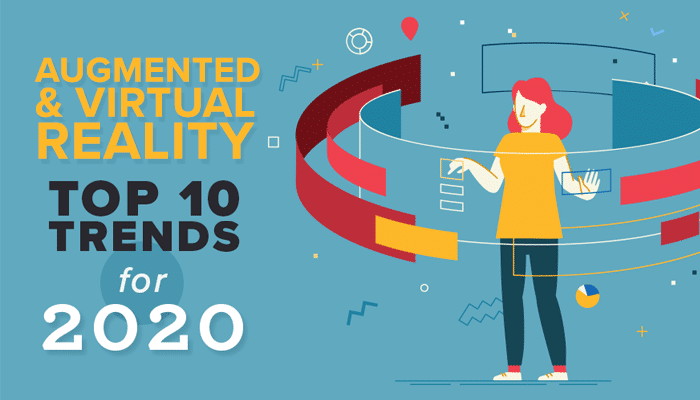
NOTE: Welcome to 3D Cloud’s (mostly) annual predictions for the coming year. This isn’t our first video to the prognostication rodeo, and you look at our 2019 predictions here. The 2019 list also exists as a podcast, which you can listen to here. For an overview of 3D Cloud business heading into the new decade, check out the Why 3D Cloud? page.
With a new decade now only a few weeks away, Virtual Reality trends and Augmented Reality trends that have been developing for the last 10 years are now more mature than ever. It’s hard to remember, but the world looked wildly different in 2010. The cutting edge smartphone was the iPhone 4, which landed in June of that year and still ran on pokey 3G networks. Samsung was primarily known for selling TVs. Android was a cute novelty project. FourSquare was the hot social network, while mobile gaming went insane for Angry Birds.
Those were simpler times.
2019 felt like the end of something, and I don’t just mean the “teens” decade. Augmented Reality is now a mature technology, even if the ideal technology for delivering AR may still be a few years away. The VR hype cycle that began back in 2014-2015 finally seemed to come to an end, with Oculus and HTC both trying out new HMD designs (The Oculus Quest and Vive Cosmos), but not reaching mass adoption. In many ways, AI and blockchain have bumped VR and AR from the headlines as the shiny new tech.
So where does that leave us heading into 2020? It’s a new decade, and tech companies, governments, the whole world are going to be looking to get off to a fast start. Here’s 10 predictions for trends we see coming in the next 12 months across technology, retail, and the pop culture at large.
Top 10 Augmented Reality and Virtual Reality Trends for 2020
1. 5G changes everything, but you won’t really notice … yet.
5G is a transformational technology, even if the slow early rollout has been less than inspiring. 2020 will see a major expansion of the current network, with 5G speeds coming to blanket most major metropolitan areas of the U.S. 5G’s big breakthrough moment will come in September, when Apple unveils the iPhone 12. The first major redesign of Apple’s flagship smartphone in three years, the all-new iPhone 12 will usher in the 5G era and be seen as the moment that 5G hit the big time. But what does this mean, beyond being able to watch YouTube on the go with less waiting? 5G is going to give a major jump-start to AR and VR software producers, who will be able to create experiences that current-generation networking technology just do not allow. Examples include: Massive, multi-user AR experiences with hundreds of users all viewing and changing the 3D content in real time with zero lag; higher quality, wireless VR headsets that can display higher resolution graphics with ease; and whole new display technologies that will blow your mind by the end of the decade. Seen Spider-Man: Far From Home yet? Yeah, like that drone rig Mysterio was using, only used to sell beer and cars instead of menace the population. We hope.
2. Forget Apple’s AR smart-glasses —they’re not coming in 2020 anyway — and focus on that amazing new iPad Pro that will map the world
The end of 2019 saw a wave of rumors about Apple’s supposed AR smartglasses. After multiple leaks that said Apple was planning for a 2020 launch of its AR smartglasses alongside the iPhone 12, November reports in The Information and Bloomberg indicated that Apple had spiked those plans and pushed their new device back to 2022 at the earliest. Hidden in the details, however, was word of an all-new iPad Pro, set to launch in March 2020 and coming with a new rear-facing 3D sensor system that’s allegedly an evolution of the existing FaceID rig.
The new iPad is said to be able to accurately map a room in seconds, and the tech is almost certain to filter into the 2020 iPhone 12. That means there could be close to 100 million devices capable of quickly mapping the environment out in the wild by the end of next year. This technology of course opens up a Pandora’s Box of privacy concerns — starting with, what’s Apple going to do with all these “maps” anyway? — but will also lead to some amazing applications. We can’t wait to get our hands on it.
3. Amazon will open grocery stores nationwide, while Microsoft and Google feasts on their cloud storage business
All eyes continue to be on Amazon, as the ecommerce Goliath looks to expand its physical footprint. 2019 saw Amazon continue to leverage its purchase of Whole Foods, but the premium nature of the Whole Foods brand (remember the old “Whole Paycheck” joke?) has Amazon looking at ways to attack the middle and lower end of the grocery market. Amazon Go concept stores have continued to pop up in new locations — there’s currently 18 automated outlets hawking grab-and-go items in big cities like New York and Seattle — but it’s hard to believe the company’s ambitions are limited to smashing together an Automat machine and a 7-11. A template of sorts may exist for Amazon in the form of Walmart Neighborhood Markets. Will the ecommerce giant follow the lead of an old-school brick and mortar titan and launch a discount grocery chain? 2020’s already looking weird!
At the same time Amazon is staking its claim in the real world, deep-pocketed competitors like Microsoft and Google are making a competitive run at Amazon Web Services (AWS) lucrative cloud storage business. The backbone of the internet has been hosted by AWS for years, but 2018 saw Microsoft grab a $10 Billion government contract that seemed destined for AWS. (The President of the United States is not a big fan of Amazon’s CEO, which may have impacted the granting of the contract.) Meanwhile, Google continues to sign up big clients to its own web-services division, largely by undercutting AWS on price while offering a slightly different mix of services. AWS is still the leader in the industry, but competition is now fierce, and AWS is sure to see declining market share in the coming years. How will the company react? The answer to that question will influence technology trends for the next decade.
4. AI assistants get upgrades to seem more human, but customer satisfaction ratings plummet in the aftermath anyway
“Hey Customer Service Bot, how do I talk to an actual person?”
“Sorry Dave, that’s just not possible right now. Good bye.”
Voice command-drive AI is already a staple of customer service systems. Dial any 1-800 “help line” and your call will be answered by a machine, which guides you through a set menu of options in the hopes of actually addressing your question. It’s hit or miss, but you can usually find your way out to a real person who can then attempt to help you. (Also hit or miss, to be honest.) The ability to “speak to an associate” is an act that will soon seem quaint. As AI assistants get better and better at parsing human speech and responding like a living, breathing person, companies will shift more and more customer service responsibilities onto them and off of human workers. The fact is AI assistants will be good enough for most queries, and they will become indistinguishable from human beings by the end of the decade — but “most” isn’t “all,” and the sheer volume of calls means millions upon millions of people will be ranting to friends and online about how stupid our new robot masters are.
5. AI will shine in assisting with specific tasks — say, helping a user personalized design ideas
While AI is going to struggle in the customer service arena, more specialized systems will shine with consumers. One area ripe for AI disruption is interior design, which is already seeing style-savvy computer systems help end users plan their next home renovation or remodeling project. We’re not at the level of Tony Stark ordering Jarvis to launch his latest Iron Man suit just yet, but picking complementary wall colors, furniture and other home accents is already well inside the capabilities of design-oriented AI systems. And with consumers moving to speech-based search via Alexa, Siri and the like, we’ll see fully speech-enabled design experiences start popping up in 2020, before fully upending the design market by 2030.
6. You’ll be the star of your own HGTV-style design show, airing on your social pages
With AI augmenting human design professionals, it’s only a matter of time before every American homeowner will have access to a personalized HGTV-style design experience, which they will then catalog and share via social media. In 2020 and beyond, shoppers looking for the latest and greatest in home remodeling and DIY will note that real time co-designing has hit the big time — whether it’s in-store with a human designer, or online with an AI. The seeds for these experiences are already available — for example, 3D room design applications are already in use for furniture, kitchens, bathrooms, and other homegoods — and retailers are pulling together all the pieces for a much more engaging and sharable shopping process. Going from inspiration to a fully redesigned version of your home is now in reach for most consumers, wherever they live and however they shop.
7. Tiny stores from major retailers invade downtowns across the country
The growth and continued development of 3D visualization technologies like Augmented and Virtual Reality are now opening to door to new brick and mortar concepts. One already taking hold is small store concepts that use AR and VR to eliminate the need for expansive showroom floors. Check out Wayfair’s first physical store, located in Boston, which opened in 2019, is less than 5,000 square feet, and includes a Virtual Reality station for viewing potential furniture purchases in 3D VR. As retail behemoths continue to trim store sizes, they are looking for other competitive advantages to lure in customers. 3D visualization is taking design services to the next level, and can easily be hosted from a comparatively tiny storefront. The ability to sell high-consideration goods from a small space is a game-changer for retail, and will supercharge commerce in the urban core even as suburban malls continue to struggle.
8. The first AR-enabled political advertisements will land in 2020
2020 is an election year, which means we will all soon be inundated with endless political advertising that blankets TV, radio, print, and online. In 2016, Facebook proved to be a major — and highly controversial — player in the election, as the parties (and a few foreign governments) used the platform to target voters with information (some would say disinformation) campaigns designed to spur them to support specific candidates. Facebook as a political force is not going away in 2020, but expect competitors like Snapchat to find ways to get in on the politicking as well — and one way that will happen is with Augmented Reality-enabled political messaging. There are many ways AR can aid a campaign ad — everything from having the candidate appear to sit at your kitchen table to discuss issues, to visual explainers that explore the issues facing voters. By the time we vote in 2028, 3D will have taken over political advertising. But 2020 is the first taste.
9. Facebook zombie accounts take over as people flee the social network over concerns about privacy and accuracy
Speaking of Facebook, the world’s largest social network has had a rocky few years. After becoming deeply embroiled in the controversy that followed the 2016 U.S. elections, the company has tried to present itself as an impartial platform for political speech that will take a decidedly hands-off approach to policing content — if you’re a candidate, that is. Facebook’s official policy is that lying in political ads is not something they need to police, which of course led to some very funny ads placed by candidates to show the insanity of Facebook’s position. For the rank and file users, timelines have become clogged with annoying memes, target ad content, and cat videos — lots and lots of cat videos. Why are we all still using Facebook?
Oh right, we aren’t. Turns out young people are abandoning the platform — reluctant to have their lives cataloged and their information sold to predatory marketers. As the youth heads over to TikTok and SnapChat, Facebook continues to grow thanks to a dwindling number of international expansion opportunities (the company is basically worldwide now) and an abundance of bots and zombie accounts. As the citizens of Facebookistan continue to age, the platform will shift more and more right in its political leanings, and will eventually turn into the Fox News of social media platforms. Congrats, Zuck. Amazing what you’ve built here.
10. AMC announces a wave of multiplex closures as the public goes all-in on streaming
AMC is the nation’s largest movie theater chain, which is a little bit like being Kodak in 1995. 2019 saw the further erosion of the “release window,” the time during which a movie plays exclusively in a theater before becoming available for at-home streaming. For example: In November, Netflix released Martin Scorsese’s The Irishman in theaters, where it played for a few weeks before debuting on the streaming service over Thanksgiving weekend. The mob opus, which starts Robert DeNiro, Al Pacino and Joe Pesci, is a “prestige drama,” and the current favorite in this year’s Oscar race. A movie like The Irishman would have previously played in theaters for months, before slowly limping into home release after the Oscars. Instead, The Irishman flopped in theaters but was a big hit on Netflix, which saw a giant wave of press coverage followed by tens of millions of people watching the movie.
Going forward, the big comic book/sci-fi “event” films will still hit the multiplex first, but all other content is going to be released simultaneously to theaters and streaming. Theater chains like AMC will continue to adapt, offering more “one night only” live events streamed to theaters, but in the end there’s going to be massive consolidation in the theater industry. The best evidence for this: AMC itself has launched a streaming service, essentially undercutting its own business. Smart move from a company that sees the writing on the giant screen.










